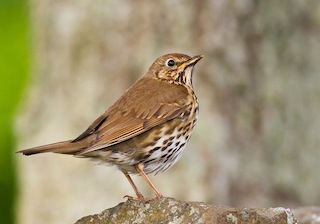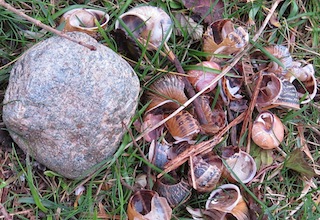 In the winter, watch out for piles of snail shells next to a rock. Chances are a Song Thrush has been using the rock as an anvil to break the shells to get at the tasty food inside.
In the winter, watch out for piles of snail shells next to a rock. Chances are a Song Thrush has been using the rock as an anvil to break the shells to get at the tasty food inside.
Photo: © Natural England/Allan Drewitt
Scientific name: Turdus philomelos
Other common names: Throstle (used by Chaucer), Mavis
Cornish name: mola is the general word for a thrush
Conservation status: IUCN Red List, Least Concern; UK Birds of Conservation Concern, Red
What to look for:
- Family: Chats and thrushes (Turdidae)
- Colouring and appearance: Brown above, creamy underparts spotted with black/dark brown marks.
- Size: 23cm length, 34cm wingspan.
- Where: Across the UK in woodland, parks, gardens, urban areas and in scrubland. Globally found across Europe and West Asia, and introduced to Australia and New Zealand.
- Call: It has earned its name through its beautiful song. The repeated musical phrases are distinctive.
- Similar species: Mistle Thrush, which is larger and more obviously spotted on its chest and underside.
 In the colder months, you might have your curiosity piqued by spotting a pile of empty snail shells discarded next to a rock or stone. This snail ‘graveyard’ is in fact the site of a Song Thrush anvil. Song Thrushes prefer to eat invertebrates that are easier to get at, with a love for fruit and earthworms in particular. However in the winter, when food is less plentiful, they will take snails as well. They smash the shell open against a stone so they can get at the tasty snail inside.
In the colder months, you might have your curiosity piqued by spotting a pile of empty snail shells discarded next to a rock or stone. This snail ‘graveyard’ is in fact the site of a Song Thrush anvil. Song Thrushes prefer to eat invertebrates that are easier to get at, with a love for fruit and earthworms in particular. However in the winter, when food is less plentiful, they will take snails as well. They smash the shell open against a stone so they can get at the tasty snail inside.
 In the spring and summer, listen out for the beautiful song from on high as a Song Thrush perches at the top of a tree or building. Each bird has up to 100 different phrases in its song, often repeated, which becomes increasingly complex as the thrush ages. This wonderful and familiar countryside melody – described by the poet Thomas Hardy (in The Darkling Thrush) as a ‘full-hearted evensong’ – is sadly becoming less common. The Song Thrush is in serious decline in the UK, probably due to factors such as changes in farming practice and loss of habitat.
In the spring and summer, listen out for the beautiful song from on high as a Song Thrush perches at the top of a tree or building. Each bird has up to 100 different phrases in its song, often repeated, which becomes increasingly complex as the thrush ages. This wonderful and familiar countryside melody – described by the poet Thomas Hardy (in The Darkling Thrush) as a ‘full-hearted evensong’ – is sadly becoming less common. The Song Thrush is in serious decline in the UK, probably due to factors such as changes in farming practice and loss of habitat.
The Song Thrush has a long breeding season, lasting from March until August, producing up to three broods. The eggs are a dark-speckled pale blue and are incubated by the female. Both male and female care for the young until they leave their parents about five weeks post-hatching.
Did you know…?
…Song Thrushes were taken to Australia by the early settlers from Britain, as a reminder of home. They did not thrive there, but are common in New Zealand.
…The species name philomelos is from Greek mythology. Philomela had her tongue cut out but was transformed into a songbird.
More information and references:
Svensson, L., Mullarney, K., Zetterstrom, D.,1986. Collins Bird Guide, second edition (translated by Christie, D., Svensson, L.). HarperCollins, London.
Published: January 2015
Author: Amanda Scott
Photos: Steve Townsend (anvil and shells); © Natural England/Allan Drewitt (Song Thrush)
